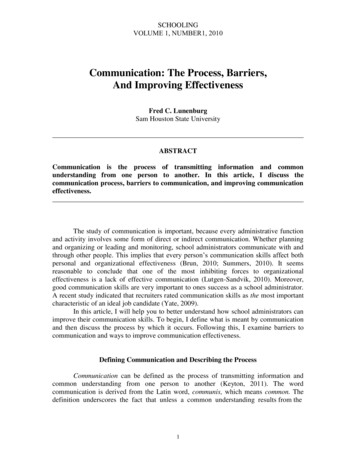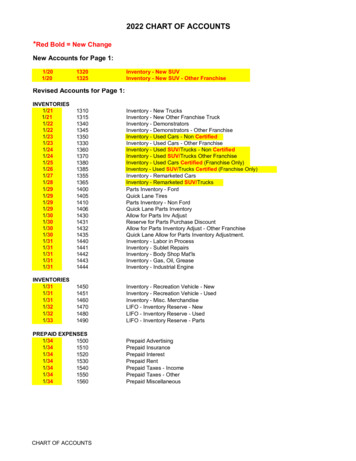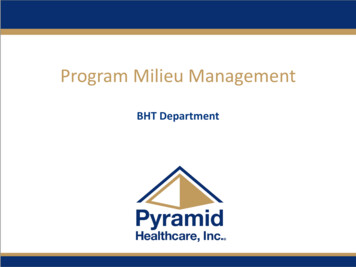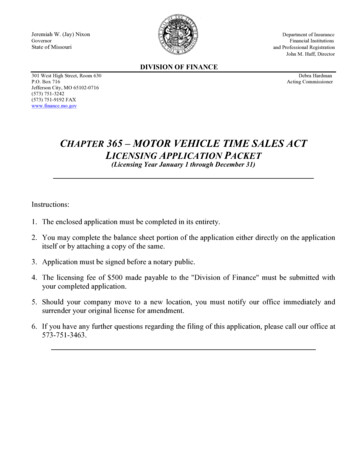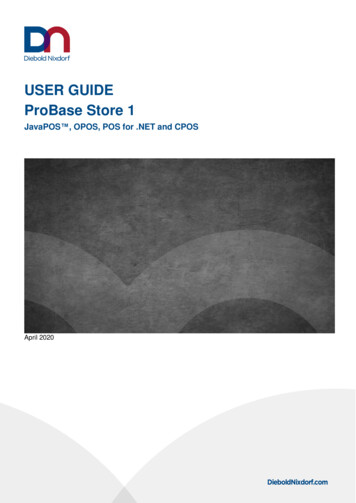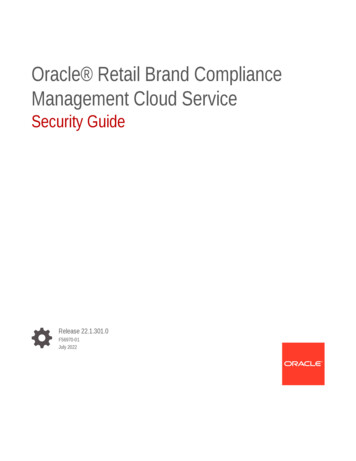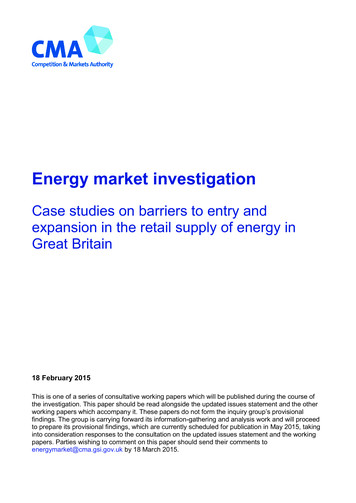
Transcription
(QHUJ\ PDUNHW LQYHVWLJDWLRQ &DVH VWXGLHV RQ EDUULHUV WR HQWU\ DQG H[SDQVLRQ LQ WKH UHWDLO VXSSO\ RI HQHUJ\ LQ *UHDW %ULWDLQ )HEUXDU\ 7KLV LV RQH RI D VHULHV RI FRQVXOWDWLYH ZRUNLQJ SDSHUV ZKLFK ZLOO EH SXEOLVKHG GXULQJ WKH FRXUVH RI WKH LQYHVWLJDWLRQ 7KLV SDSHU VKRXOG EH UHDG DORQJVLGH WKH XSGDWHG LVVXHV VWDWHPHQW DQG WKH RWKHU ZRUNLQJ SDSHUV ZKLFK DFFRPSDQ\ LW 7KHVH SDSHUV GR QRW IRUP WKH LQTXLU\ JURXS¶V SURYLVLRQDO ILQGLQJV 7KH JURXS LV FDUU\LQJ IRUZDUG LWV LQIRUPDWLRQ JDWKHULQJ DQG DQDO\VLV ZRUN DQG ZLOO SURFHHG WR SUHSDUH LWV SURYLVLRQDO ILQGLQJV ZKLFK DUH FXUUHQWO\ VFKHGXOHG IRU SXEOLFDWLRQ LQ 0D\ WDNLQJ LQWR FRQVLGHUDWLRQ UHVSRQVHV WR WKH FRQVXOWDWLRQ RQ WKH XSGDWHG LVVXHV VWDWHPHQW DQG WKH ZRUNLQJ SDSHUV 3DUWLHV ZLVKLQJ WR FRPPHQW RQ WKLV SDSHU VKRXOG VHQG WKHLU FRPPHQWV WR HQHUJ\PDUNHW#FPD JVL JRY XN E\ 0DUFK
Crown copyright 2015You may reuse this information (not including logos) free of charge in any format ormedium, under the terms of the Open Government Licence.To view this licence, visit ence/ or write to the Information Policy Team, The National Archives, Kew, LondonTW9 4DU, or email: psi@nationalarchives.gsi.gov.uk.
ContentsPageSummary . 3Introduction . 3Independent suppliers . 4Summary of potential barriers to entry and expansion . 6Costs of market entry . 7Access to wholesale energy . 10Vertical integration (VI). 14Supplier IT systems and technical expertise . 16Industry systems and settlement . 19Regulatory risks . 20Customer inertia . 24Reputational risks . 28Economies of scale and scope . 29Obligations thresholds. 302
Summary1.This paper sets out evidence that we have collected through a series ofinterviews with independent energy suppliers on the extent and nature ofbarriers to entry and expansion in the retail supply of electricity and gas inGreat Britain (GB).2.In considering entry and expansion barriers, we studied features of the marketthat may prevent or restrict companies from exploiting profitable opportunitiesin a market and hence enable incumbents (ie Centrica, EDF Energy (EDF),E.ON, RWE npower, Scottish Power and Scottish and Southern Energy(SSE)) persistently to raise prices above costs without significant loss ofmarket share.13.For the purpose of this paper, we use the term ‘independent suppliers’ to referto The Co-operative Energy, Ecotricity, First Utility, Haven Power, OvoEnergy, Utilita, Extraenergy and Utility Warehouse. We use the term ‘SixLarge Energy Firms’ to refer to Centrica, EDF, E.ON, RWE npower, ScottishPower and SSE.Introduction4.We conducted eight case interviews with the independent suppliers to discusstheir individual market entry and expansion experience and to understand anybarriers or issues they encountered.5.We have also put together a Retail Supply Financial and Market Questionnaire (‘Questionnaire’) that we circulated to four independent suppliers,namely The Co-operative Energy, Ovo Energy, First Utility and UtilityWarehouse. We asked questions relating to their entry and expansionexperience in the retail supply of energy in GB market.6.The independent suppliers are not a homogenous group of suppliers; ratherthey operate in different parts of the market (ie domestic, small- and mediumsized enterprises (SMEs), prepayment meters, renewable energy, etc) andhave different strategies. Consequently each has its own perspective on howthe energy market operates.7.We selected which independent suppliers to interview to ensure we havegood coverage of this part of the supply market and were able to get theviews of established firms, those new to the market and those that are rapidlyexpanding. We also sought to cover a range of entry strategies by1Market studies and investigations – guidance on the CMA’s approach: CMA3.3
interviewing those firms that chose to target certain customer segments suchas prepayment or smart meters.8.From each firm we sought to gain an understanding of how they entered theGB energy supply market, to identify what research they conducted beforeentering, and how they perceived the risks and opportunities in the GBmarket. We also wanted to understand how their entry plans had materialisedand how this compared to their expectations.9.The views expressed in this paper reflect the experiences of the smaller, andtypically non-vertically integrated, market participants who have enteredrelatively recently and have grown organically without the benefit of anincumbent customer base. This forms part of a broader body of work onbarriers to entry and expansion, which will consider the views of other marketparticipants.10.This paper sets out brief introductions to the eight independent suppliers thatwe interviewed, followed by a summary of their views noted under key headingsof potential barriers to entry and expansion.Independent suppliers11.Independent suppliers have continued to see significant growth in the domestic retail market, according to a report by Cornwall Energy.2 The company’slatest survey of market shares found that, in the quarter to 31 October, the 20companies outside the Six Large Energy Firms added 635,000 domesticenergy accounts to reach a total of 4.35 million, giving them an 8.7% share oftotal accounts. More than 2 million households, equivalent to 10.4% of allhouseholds in GB, were buying dual fuel energy from independent suppliers,according to the report. It added that, taken collectively, the independentsuppliers now ranked fourth highest by market share in the domestic dual fuelmarket.12.The eight interviews were carried out bilaterally over the course of four weekswith the following suppliers:3(a) Ovo Energy, founded by Stephen Fitzpatrick in 2009 and headquarteredin Bristol. Predominantly a supplier of electricity and gas to domesticcustomers.2Independent suppliers surge on to 8.7% of household energy market by taking more than 10% of dual fuelcontracts.3CMA desktop research.4
(b) Extraenergy, a new energy supplier who entered the market in 2014. Itmarkets itself as a discount energy provider.(c) Utilita, an energy supplier that entered the GB supply market in 2003 andfocuses on smart prepayment meters installed at no extra charge.(d) Utility Warehouse, an all-encompassing utility provider, founded in 1996.It supplies gas, electricity, landline, broadband and mobile services. Upuntil December 2013, Utility Warehouse was a ‘white label’ provider incollaboration with RWE npower. In December 2013, Utility Warehousebrought back in-house the supply of energy from RWE npower.(e) First Utility, licensed as a supplier of electricity and gas to the GB marketin 2006 and offering mass market energy services from 2008. It iscurrently the seventh largest energy supplier in the GB market. It was thefirst company in the GB market to offer smart meters to its residentialcustomers.(f) The Co-operative Energy is part of the Midcounties Co-operative, thelargest independent co-operative in GB. Its entry into the GB energysupply market occurred in 2010.(g) Ecotricity was founded in 1995 and first started to supply customers in1996. Focused on green energy, it is one of the few small suppliers tooperate generation assets as well as supplying energy.(h) Haven Power, owned by the large GB electricity generator Drax, whichacquired it in 2009. Haven Power was set up in 2006 to supply theelectricity needs of small- to medium-sized businesses.5
TABLE 1 Snapshot summary of independent suppliersSupplier nameYear ofmarket entryUltimate parentDomestic energycustomersMethod of sourcing wholesale energyFirst Utility2006Impello plc550,000Structured deal with ShellOvo Energy2009Ovo Group Ltd420,000Trading and credit arrangement with athird partyCo-operative Energy2010The MidcountiesCo-operative Ltd260,000Wholesale markets (working capitalfunding from ultimate parent)Utility Warehouse1996Telecom Plus plc(listed)800,000 supplypointsExtraenergy2014Extra EnergieGermany120,000Wholesale markets (working capitalfunding from ultimate parent)Utilita2003Privately-owned100,000Wholesale markets (posting cashcollateral for trades)Ecotricity1996Ecotricity Group140,000Wholesale markets (working capitalfunding from ultimate parent)Haven Power2006Drax Group PlcOnly SME and I&CLong-term wholesale supply agreementwith RWE npowerWholesale markets / Drax GroupSource: Information provided to the CMA over the course of the interviews.Summary of potential barriers to entry and expansion13.We identified three possible methods of entry into the energy supply market inGB:(a) Organic entry: this represents the most common method of entry,whereby a potential entrant applies to the Office of Gas and ElectricityMarkets (Ofgem) for a new supply licence and sets about putting in placethe necessary business and systems infrastructure to commence its retailsupply operations.(b) Acquisitions: recent examples of entry via an acquisition of an incumbentretail energy supplier appear limited to very large-scale entry asevidenced by the market entry of some of the Six Large Energy Firms’ultimate parent companies, namely E.ON Group, EDF Group, IberdrolaGroup (ie Scottish Power), Drax (Haven Power) and RWE Group.(c) White-label arrangement: finally, a less common method of entry is the‘white-label’ route whereby a potential entrant achieves a retail presenceas an energy supplier (eg by marketing its retail offering under its ownbrand) through having an arrangement with an incumbent retail energysupplier to supply the energy to retail customers on its behalf. There aretwo main white-label suppliers, namely Sainsbury’s Energy and M&SEnergy through their respective partnership arrangements with Centricaand SSE.6
14.We identified the following recurring themes from interviews and from theanswers we received to the Questionnaire with the independent suppliers:(a) costs of market entry;(b) access to wholesale energy:(i) liquidity; and(ii) collateral;(c) vertical integration (VI);(d) supplier IT systems and technical expertise;(e) industry systems and settlement;(f) regulatory risks;(g) customer inertia;(h) reputational risks;(i) economies of scale; and(j) obligations thresholds.15.In the following section we summarise the views of the independent suppliersunder each of these headings.Costs of market entry16.In relation to whether the costs of market entry might be considered apotential barrier to entry, we noted the number of applications submitted toOfgem between 2005 and 2013, of which 91% were granted by Ofgem.4Source: Ofgem. In some years more licences have been granted than applications received where applicationshave rolled over from one year to the next. In years with fewer licences granted than applied for, this is becauseapplications were either withdrawn by the applicant or the application cancelled.47
FIGURE 1Electricity supply licences (count)2522201515101618181817137 75022211 12007200820092010Licence applications201120122013Licences grantedSource: Ofgem.FIGURE 2Gas supply licences (count)252015105020 1918 17131396 6520072008111113420092010Licence applications201120122013Licences grantedSource: Ofgem.17.At one end of the spectrum, market entry can take place at a very small scale,requiring a total initial capital outlay of 100,000. We found that financing theinitial capital outlay for organic entry was predominantly through equity, egpersonal funds.18.Ovo Energy told us that its founder spent approximately 400,000 to enter theGB supply market. Around half of that was used to set up the systems andobtain the licences required to operate in the GB market. Much of theaccreditation process could be outsourced which helps simplify the setting upof a new supplier.8
19.Ovo Energy believed that the industry was complicated; it said that it took 12months prior to launch for it to understand the market well enough to preparea good enough business model.20.The Co-operative Energy told us that there was a substantial period ofextensive research and planning prior to Midcounties Co-op committing tocreating The Co-operative Energy. It saw that it was possible to start at amodest scale, from other independents’ experience in the market. Theexpectations were that the break-even point would be between 20,000 and25,000 customers.21.In its answer to the Questionnaire, The Co-operative Energy told us that itsinitial capital costs were almost non-existent as the system contract it signedwas linked to its growth plans rather than a significant initial outlay. It also toldus that it would consider recruitment expenditure to be a significant initial noncapital expense.22.[ ]23.Extraenergy believed that the cost of market entry in GB was too low and itshould be higher with higher barriers to obtain a licence. It believed that it‘should be a certain limitation or a criterion for an entity to come into themarket, to show that it has the financial strength to do so.’24.Ecotricity did not confirm the amount it spent on systems start-up costs at thetime when it entered the supply business. However, it told us that nowadaysthe cost of legal advice was high for a small company, therefore there was alot of investment that was required for that. Ecotricity estimated thisinvestment to be in the hundreds of thousands of pounds.25.First Utility spent between 500,000 and 600,000 to get accredited and up toabout 750,000 to get the company going. It classified its market entry as a‘lean’ entry and it believed that it had invested a lot in the company as it hadgrown.26.In its answer to the Questionnaire, First Utility told us that it entered at a smallscale in order to test the entry propositions being followed (which includednew-build and SMEs and that its approach was pragmatic, in that furtherinvestment was made following testing of entry propositions and assessmentof the future opportunities.27.Utilita told us that back in 2003/04 when it looked at entering the market it hadto do a full electricity accreditation, which was quite a long-winded, year-longprocess of getting into the market. However, for gas it got a ‘supplier-in-a-box’9
licence without any kind of formal market testing. It told us that there were noentry tests for gas.28.Utilita also told us that when it entered the market, one of the problems fornew entrants in the domestic market was the inability to sign a long-termcontract. One of the reasons for more market entries into the SME marketwas the size and length of energy contracts per customer; suppliers couldsign a long-term deal with a commercial customer. It told us that supplierscould not do that in a residential market and they were stuck with a 28-daytariff because Ofgem stopped suppliers from signing long-term contracts withresidential consumers.Access to wholesale energyLiquidity29.Ovo Energy started buying gas and electricity through a third party. With thesmall volumes it had required initially it was hard to get a cost-effectivecontract, however it made the point that this had been no more difficult than inany other market. It had also approached other large financial institutions butit had not been interested because in its view, Ovo Energy was too small.30.Ovo Energy made the decision quite early on that it wanted to buy the mostliquid product in the market. Its experience in trading led it to understand thatin any market the more complex the product that it was trying to buy thebigger the margin that the counterparty would take, therefore at the beginningOvo Energy bought base-load products and then managed the shaping risk. Itoutsourced half-hourly execution to a third party, which ran a 24-hour tradingdesk on behalf of three large power stations, therefore that third party wasalso running the execution desk for them.31.Ovo Energy believed that the reason there was greater market liquidity incountries like Germany was because there was more retail competition. Itbelieved that by improving retail competition the wholesale market would alsoimprove.32.The Co-operative Energy told us that it had not had any difficulty in gettinggood liquidity from suppliers in the wholesale market. It had not had anyissues with getting the power and gas that it needed. From day one it wasable to get all the Purchase Power Agreements (PPA) required for itselectricity needs. In its opinion, probably the hardest thing had beenbenchmarking that price against others in the industry when there was noliquidity. It was able to purchase standard products, and incurred sometransaction costs to try to shape the demand on the weeks ahead.10
33.Haven Power had difficulty sourcing the power requirements it needed beforeit was acquired by Drax, in a distressed sale from Carron Energy in 2009. Thisissue was in part due to the purchasing arrangement it had with CarronEnergy which had not been able to purchase the generation capacity that itneeded.34.When Haven Power first considered entering the market in 2003, it spent a lotof time talking to generators. It had one discussion with Drax (in passing) butDrax was not interested in supply at that time. It had many discussions withsome of the Six Large Energy Firms and independent aggregators, but it wasvery difficult to be treated seriously. It had strong interest at the time frombanks in terms of providing working capital but despite that, it was difficult tobe taken seriously by generators. Haven Power eventually entered the SMEelectricity supply market in 2007.35.Extraenergy told us that the exchanges market was not suitable for smallersuppliers without a big customer base, hence all its trades were done overthe-counter (OTC). In terms of having the right customer base to trade onexchanges and being able to build a sizeable customer base when restrictedto OTC trading only. It believed that ‘it is the chicken and the egg issue’.36.Extraenergy told us that when starting as an alternative supplier with all of thechallenges relating to building up a customer base, and the capital requirements that a supplier needed in order to actually build up a customer base, toactually get into the exchanges market with very little volume was somethingthat was not reasonable. It believed that a supplier needed to grow fast andbuild up its customer base to levels that made sense to trade on exchangesbut in order to do so it needed liquidity, systems and IT.37.First Utility told us that the biggest challenge to entering the GB energymarket was finding someone to buy the energy from. As a small supplierbuying shaped products was difficult; small suppliers could only enhance theirmarket position by base-load and peak because of very small volumes. FirstUtility identified the need to work with a counterparty who provided it withaccess to the wholesale market and gave it the lower volumes that it needed.38.In its view, obtaining energy from the Six Large Energy Firms was difficult forFirst Utility, and therefore, it started making progress with International Powerand then Morgan Stanley. Morgan Stanley provided it with granularity andshape, hence it took on that risk. First Utility believed that Morgan Stanleyprobably aggregated its demand with other customers and managed the risk.39.In its answer to the Questionnaire, First Utility told us that it was concernedabout continuity of access to wholesale markets in the right volumes as it11
grew. It raised concerns about liquidity in the spot market and also its fear thatwholesale electricity markets were not sufficiently liquid in the products itrequired to enable normal hedging activities to mitigate market risk to operatesmoothly.40.In addition, First Utility also raised concerns around the wholesale marketcounterparty options in the Questionnaire. It believed that a genuinely liquidmarket would attract on a continuing basis innovative providers offering toaddress market price and volume risk, credit and collateral, working capital, andother challenges for all independent suppliers, including new entrants.Collateral41.Ovo Energy had to pay a premium to an insurer to cover the mark-to-marketlosses with counterparties in the early stages of operations. It was costeffective but it had outgrown this arrangement quickly. Such an arrangementwas possibly not scalable but suited Ovo Energy at the time of market entry.42.Ovo Energy made the point that for companies whose businesses were soundand run well it was possible to obtain collateral-free trading. It said that energytrading was neither easy, but nor should it be easy. It did not agree with someother small suppliers that there should be a hand-out or free credit support.43.In its current agreement with counterparties, Ovo Energy paid a fee permegawatt hour, in lieu of credit support, similar to paying an insurer tounderwrite its credit risk. It paid a premium on top of wholesale costs to itstrading counterparty to avoid the need to post collateral.44.Utility Warehouse told us that it originally had access to the wholesaleelectricity market through Enron Direct. Later when this was bought by BritishGas, Utility Warehouse got its electricity from International Power through anew company (called Opus Energy) set up by some of the Enron Direct staff.Opus Energy charged Utility Warehouse a small premium over the mark-tomarket price for the hedge book that it was building and ran, but UtilityWarehouse was not exposed to mark-to-market calls on any pricefluctuations. It believed that on the back of this arrangement, it had built asensible hedge book for its electricity needs that would have been broadlysimilar to the shape that the Six Large Energy Firms would have had at thattime.45.Utility Warehouse told us that buying gas was more complicated. At the timeof market entry, it was buying gas from BP and shipping through Aquila but itdid not have a big enough balance sheet to hedge its gas exposure. Thehedging issue arose because of collateral requirements but more importantly12
the mark-to-market calls that could have arisen. It ended up buying effectivelya month ahead and then balancing in the daily market, through to the autumnof 2005. In the autumn of 2005, there was an interruption to supply, and thewholesale gas price spiked. It believed that because the Six Large EnergyFirms were hedged, it could afford to continue to supply its customers atbelow the market price. In light of all these developments, it had a choicebetween continuing to sell gas in line with the prices being charged by the SixLarge Energy Firms and make a significant loss, or put up prices to reflect theprice that it was paying and be uncompetitive and lose customers. It told usthat the only solution it saw was to go around to the Six Large Energy Firmsand discuss potential solutions. The only one that it got any serious tractionwith was RWE npower. RWE npower saw the value of its distribution channeland its independent brand and agreed to take over the entire gas andelectricity customer base. At that time it had two energy supply companies,Gas Plus and Electricity Plus. RWE npower agreed to take over its gas andelectricity customers, supply them from its hedged portfolio, pay the wholesalecosts, network and obligation costs and give Utility Warehouse a margin tocontinue to provide all the customer service elements.46.Utility Warehouse was able to secure an improved commercial deal with RWEnpower in 2011 under which RWE npower provided all the working capitalassociated with the growth of the energy business and Utility Warehousewould receive an enhanced margin linked to achievement of certain growthtargets. In December 2013, it signed a new 20-year supply agreement as partof the buyback of its original supply licences from RWE npower (whichincluded all the Utility Warehouse customer energy contracts). Under thelatest agreement, RWE npower would continue providing working capitalrelated to the hedge book and also the working capital related to customerbudget plans.47.The Co-operative Energy told us that it was not required to post cashcollateral for energy trades because of its strong parent company guaranteefrom Midcounties.48.Utilita told us that collateralisation of trades could be extremely expensive. If itwanted to trade further out than 24 months it became very expensive withcertain counterparties. Utilita also found it difficult to get meaningful creditfacilities with the banks.49.Utilita told us that it was going through a process of making forecasting andtrading activities more sophisticated and building up more counterparties. Inthe future, it would like to get back on to exchanges and trade in that manner.It told us that at the moment, it could not afford to collateralise manycounterparties, so it had a relatively small number of counterparties to trade13
with. It also made the point that the value of trade that Utilita did for a day, toget from a rough hedged position to a half-hourly hedged position, wasrelatively small, hence getting anyone interested in doing these trades wasvery difficult.50.Utilita also told us that the collateral that it was posting on exchanges wascash that it generated within the business, it did not have bank facilities forcollateral and that it saw this arrangement as a clear barrier to expansion fromits perspective.51.Haven Power told us that the credit crunch in 2008 had put it in survival modeand it had had to cut back sales dramatically because it could not afford to doanything that required cash flow. That was when Carron (by then called WelshPower) put Haven Power up for sale and Drax acquired it. In 2008 purchasingshaped products was difficult as there were few suppliers and these came ata premium price.52.Extraenergy believed that credit liquidity was the main issue in accessing thewholesale markets. [ ]53.[ ]54.Ecotricity believed that liquidity was probably less of an issue than it was inthe past, but continued to be an issue nonetheless. Credit availability wasprobably the single biggest issue faced by new entrants in terms of needingcash to enter the market. It believed that it had passed this issue for themoment thanks to its parent company guarantee.55.First Utility told us that it had recently moved its trading agreements to ShellEnergy on a structured basis. Its current arrangement with Shell was thatShell provided it with access to the wholesale market. Shell held a debentureover First Utility’s assets. First Utility had the flexibility to purchase anyproduct available in the market and any size. [ ] Nonetheless, First Utilitytook the shape risk, it bought the total volume it needed, but only the productsthat were available, and shaped it closer to delivery.Vertical integration56.Ovo Energy said that, as far as it was concerned, not being vertically integrated was an advantage. In its view, the price was set between a marginalseller and a marginal buyer, so the marginal seller should be the most efficientgenerator of electricity. More efficient generation technology came out all thetime and therefore if Ovo Energy owned an old power station, it would have totransfer more expensive electricity into its retail portfolio than it would buy14
from the most efficient generator. It told us that it did not see verticalintegration (VI) as a barrier to expansion.57.The Co-operative Energy believed that VI allowed internal pricing to distort theunderlying prices. It could not be a completely competitive market without theseparation of generation and supply. It believed that ownership under oneumbrella still provided a benefit to the ultimate parent, but operationalseparation of generation and supply with all of the power going through anopen market would give the true prices and the price signals for a faircompetitive electricity market.58.The Co-operative Energy believed that it was disadvantaged by not beingvertically integrated, because of the uncertainty around the pricing mechanismand its inability to match its position in days. It also believed that the reformsgoing through at the moment in terms of cash-out would potentially haveprofound effects for independents in times of volatility.59.Utilita told us that the smaller suppliers had a bigger proportion of the energyimbalance than the big suppliers that were vertically integrated. Asimbalanced costs were paid into a pot and redistributed based on marketshare, it believed that smaller suppliers paid more into the pot than theyproportionately got back.60.Utilita also told us that it traded on standard products and every week it did abalancing trade. It did not balance on a daily basis because there was notenough value in it. Utilita did not see the value in employing half a dozentraders to trade around the clock to balance its position all of the time. AsUtilita’s portfolio got bigger, it became more val
(c) White-label arrangement: finally, a less common method of entry is the 'white-label' route whereby a potential entrant achieves a retail presence as an energy supplier (eg by marketing its retail offering under its own brand) through having an arrangement with an incumbent retail energy
